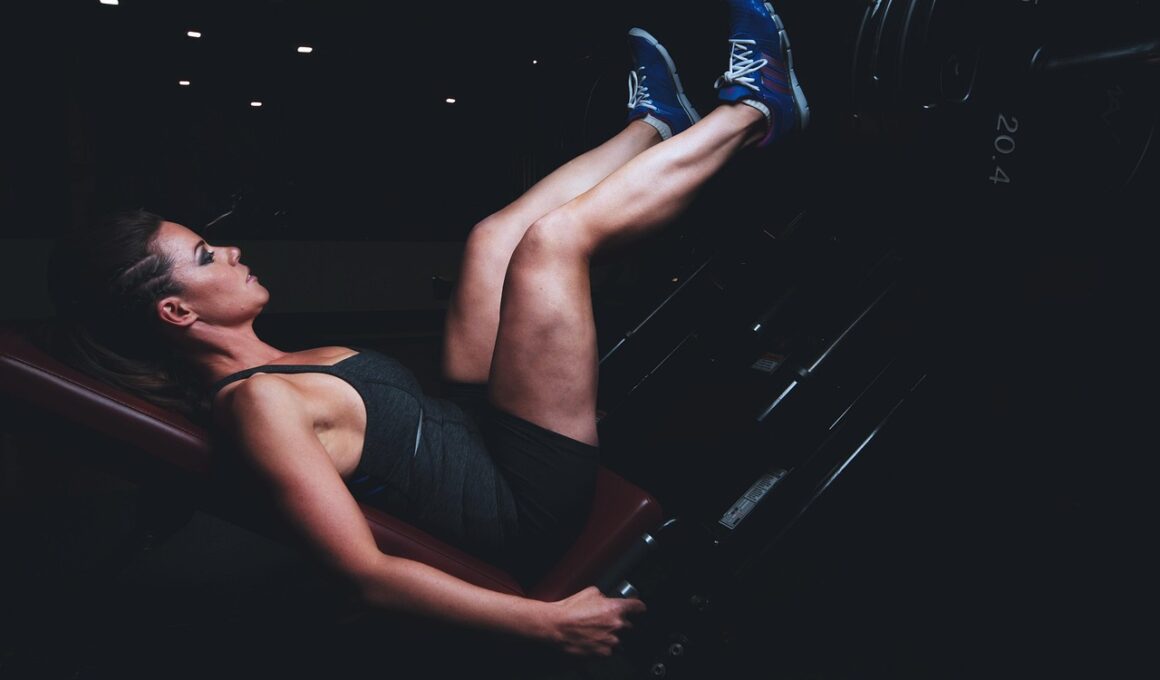Warm-Up and Cool-Down Resistance Band Exercises for Legs
If you are looking to improve your leg workouts, incorporating resistance bands is an excellent strategy. Resistance bands provide versatile options for leg exercises, allowing you to effectively target muscles without the need for heavy weights. As a warm-up, consider the resistance band leg curls. This exercise is designed to activate the hamstrings and gradually increase blood flow to the muscles. Start by anchoring the band around a stable object and wrapping the other end around your ankle. Slowly curl your leg up towards your glute, feeling the resistance throughout the motion. Aim for 10-15 reps per leg to engage those muscles fully. Additionally, another warm-up option includes lateral band walks, which activate the glutes and outer thighs. Place a resistance band around your ankles and take small steps sideways. Do this for about 10-15 steps in each direction. These warm-ups ensure your muscles are adequately prepared for the workout ahead, reducing the risk of injury. Remember, effective warm-up routines can set the tone for your resistance band leg workouts.
As we move into the main portion of the workout, it’s crucial to maintain consistency and prioritize form. One effective exercise is the resistance band squat. To perform this, stand on the band with your feet shoulder-width apart while holding the handles at shoulder height. Lower into a squat, making sure to keep your knees over your toes and your back straight. This exercise not only strengthens the quadriceps but also engages the glutes and hamstrings. Aim for three sets of 10-15 reps to maximize effectiveness. To add variety, try the split squats using resistance bands. Place one foot in the band while anchored behind you, and lower into a lunge position. This exercise will challenge your balance and strengthen your legs. Following these exercises, consider calf raises. Standing on the band, push through your toes to lift your heels off the ground and slowly return. Aim for 12-15 reps, focusing on controlled movements. Incorporating these exercises will help you build a strong leg foundation and enhance overall lower body strength, setting the stage for impressive results.
Stretching for Recovery
After completing your resistance band leg workout, it’s equally important to cool down effectively. The right stretching routine can significantly help in recovery and flexibility. Start with a standing quadriceps stretch by pulling one foot towards your glute while balancing on the opposite leg. Hold for 15-30 seconds before switching sides to ensure both legs are adequately stretched. Another beneficial stretch is the hamstring stretch. Sit on the ground with one leg extended while bending the other; reach towards your toes on the extended leg, feeling the stretch in your hamstrings. Hold for at least 15 seconds per side. Additionally, consider using a resistance band during your stretching routine. Place the band around your foot while lying flat, and extend your leg upwards. This will allow for a deeper stretch in the hamstrings and calves. As you cool down, always remember to breathe deeply. Deep breathing helps relax the body and reduces tension in the muscles after an intense workout. A consistent cool-down routine contributes to overall muscle health and prepares your legs for future workouts.
Incorporating resistance bands into your leg warm-up and cool-down routines is time-efficient and effective. These bands allow you to customize your exercises based on your fitness level and goals. Remember to check the resistance level of the bands you are using, as this can significantly impact your workout’s effectiveness. If you find a band too easy, consider switching to a stronger band that provides more challenge. Conversely, a lighter resistance band can help you focus on perfecting your form, particularly for beginners. Resistance bands can also be easily transported, making them perfect for workouts at home, at the gym, or even while traveling. Additionally, integrating these bands into your routine can help you achieve balanced development of leg muscles, enhancing both aesthetics and functional strength. The ability to adjust resistance allows each workout session to be tailored to your personal progress. Routine variations are essential to prevent plateaus in strength training, and resistance bands can provide new angles for muscle engagement. This adaptability ensures you never get bored with your workouts and consistently stay motivated.
Stay Hydrated and Nourished
To further enhance your fitness routine, focus on hydration and nutrition. Staying hydrated is essential during any workout, particularly intensive leg exercises. Dehydration can lead to fatigue, which may hinder performance and recovery. Aim to drink water before, during, and after your workouts. Additionally, consider incorporating electrolyte-rich drinks after a long or intense session. These will help replenish lost minerals and keep your muscles functioning optimally. Nutrition also plays a vital role; consuming a balanced diet rich in protein, healthy fats, and carbohydrates will fuel your workouts. Pre-workout meals should ideally consist of complex carbohydrates for energy, such as whole grains or fruits. Post-workout, ensure a source of protein to support muscle recovery, such as a protein shake or lean meats. Regular meals help maintain muscle mass and promote faster recovery time. Also, don’t forget the importance of fiber-rich foods for overall health, which can improve digestion and nutrient absorption. Keeping your body well hydrated and well-nourished complements the fitness benefits of resistance band workouts, ensuring sustained energy and quick recovery.
Leg workouts with resistance bands provide an innovative approach to enhancing strength, flexibility, and conditioning. With the right exercises, you can effectively train different muscle groups while keeping your workouts engaging and versatile. As you practice these exercises, focus on engaging your core, maintaining proper form, and paying attention to the muscle you are working. This focus not only improves muscle growth but also helps prevent injuries. Varying your routine will also keep you motivated and challenge your body in new ways. Make it a habit to schedule resistance band leg workouts regularly, perhaps considering a weekly workout calendar. Consistency is key to seeing results and improvements in strength and endurance over time. Don’t hesitate to experiment with new exercises or modify existing ones to suit your preferences. This adaptability ensures you’re more likely to stick with your workouts over the long term. Moreover, consider tracking your progress, whether by noting your reps, weight, or how you feel during workouts. This will help you stay engaged and committed to your leg training journey.
Final Thoughts
Ultimately, using resistance bands in leg workouts is an accessible and effective method for anyone seeking to improve their fitness. Whether you are a beginner or an experienced athlete, these bands offer a variety of exercises to enhance leg strength and flexibility. Remember that warming up and cooling down are essential components of any exercise routine, especially when working with resistance bands. The proper warm-up prepares your muscles for the upcoming workload, while a good cool-down routine helps in recovery and injury prevention. Consistently incorporate resistance bands into your leg workouts, and you will build lasting strength which translates into overall better fitness. The adaptability, portability, and effectiveness of resistance bands make them an excellent choice for diverse train styles and environments. As you develop a routine, consider song playlists, workout buddy, or engaging in fitness communities for additional motivation. With commitment and creativity, resistance band leg workouts can be enjoyable and rewarding. Give them a try, and you may discover enhanced performance in daily activities and physical endeavors.
Examples of these workouts are crucial for visual understanding. For the leg curls, search online for tutorials featuring resistance bands for visual learning. Similarly, for effective lateral band walks, videos can be especially helpful. Illustrations or videos showcasing these routines can enhance your grasp on how to execute these moves correctly. The importance of form cannot be overstated; incorrect form may not target muscles effectively and can lead to injuries. Hence, researching proper techniques through credible websites or fitness platforms is wise. Numerous fitness blogs and YouTube channels are dedicated exclusively to resistance band workouts. Check out this resource for more examples and step-by-step guides. Additionally, social media platforms like Instagram or TikTok also feature more dynamic content on resistance bands and exercises you can incorporate. Online communities and forums can also provide shared experiences and tips from others who practice resistance band workouts. Don’t hesitate to reach out and ask questions. The journey toward improved leg strength and fitness continues with education and practical application of various resistance band techniques.


